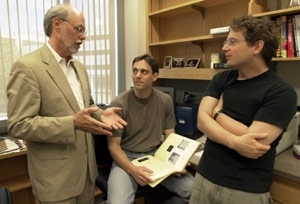MIT researchers have developed a computational method to predict which sequences of genetic material get spliced out, like outtakes of film on the cutting room floor, and which end up as the blueprint for life.
The discovery was reported on July 11 in Science Express, the online version of Science, by four MIT researchers led by Assistant Professor Christopher B. Burge.
The messenger RNA (mRNA) acts as a template for all the proteins that create a human being. This study represents one of the first times that computational methods have been used to successfully predict the function of molecular sequences in mRNA. This information could be used to predict which genetic mutations interfere with the splicing process by which mRNAs are created, potentially causing disease.
IN AND OUT
Messenger RNA molecules typically contain strings of genetic material called exons, which code for proteins, and introns, which do not. Introns, like film outtakes, are removed from messenger RNA by a splicing mechanism that joins exons together. Surprisingly, the exons make up only a few percent of the genetic material in human cells. RNA splicing determines which segments in the lengthy stream of genetic material that makes up a gene end up being expressed and which do not.
The MIT researchers have found a way to predict which mutations in a gene's exons are likely to cause the exons to be skipped by the splicing machinery. Skipping of exons typically results in inactivation of the gene's product, which can lead to disease.
The goal of the study was to identify exonic splicing enhancers (ESEs). These are short RNA sequences that, when present in the exons of a human gene, enhance the splicing of the exons and thereby increase the proportion of mRNAs that contain these exons. "We developed a computational method to predict which sequences would function as ESEs, and then did experiments to test these predictions and found that all of the sequences predicted to function as splicing enhancers did indeed have this activity," Burge said.
This work was the result of a collaboration between Burge's laboratory in the Department of Biology and the laboratory of Nobel laureate Phillip A. Sharp, professor of biology and director of the McGovern Institute for Brain Research at MIT. William G. Fairbrother, a postdoctoral associate at the MIT Center for Cancer Research, and Ru-Fang Yeh, a postdoctoral associate in the Department of Biology, shared first authorship on the paper.
To better understand RNA splicing, the researchers hope to determine a set of rules, perhaps encoded in a computer algorithm, that accurately predicts the splicing pattern of RNA transcripts. "Eventually, we hope to be able to fully understand and model the process by which exons and introns are identified by the human RNA splicing machinery," said Burge.
This research was supported by grants from the Burroughs Wellcome Fund and the National Institutes of Health.
A version of this article appeared in MIT Tech Talk on July 17, 2002.






